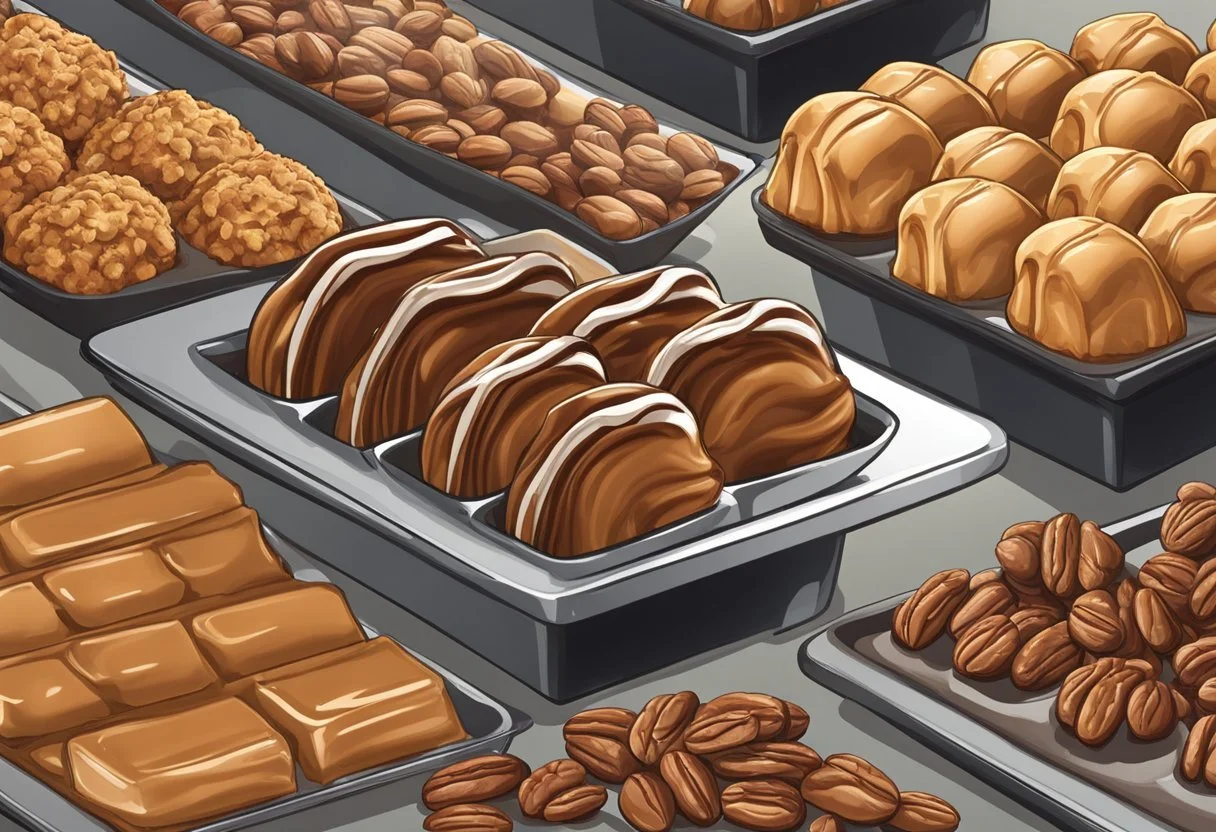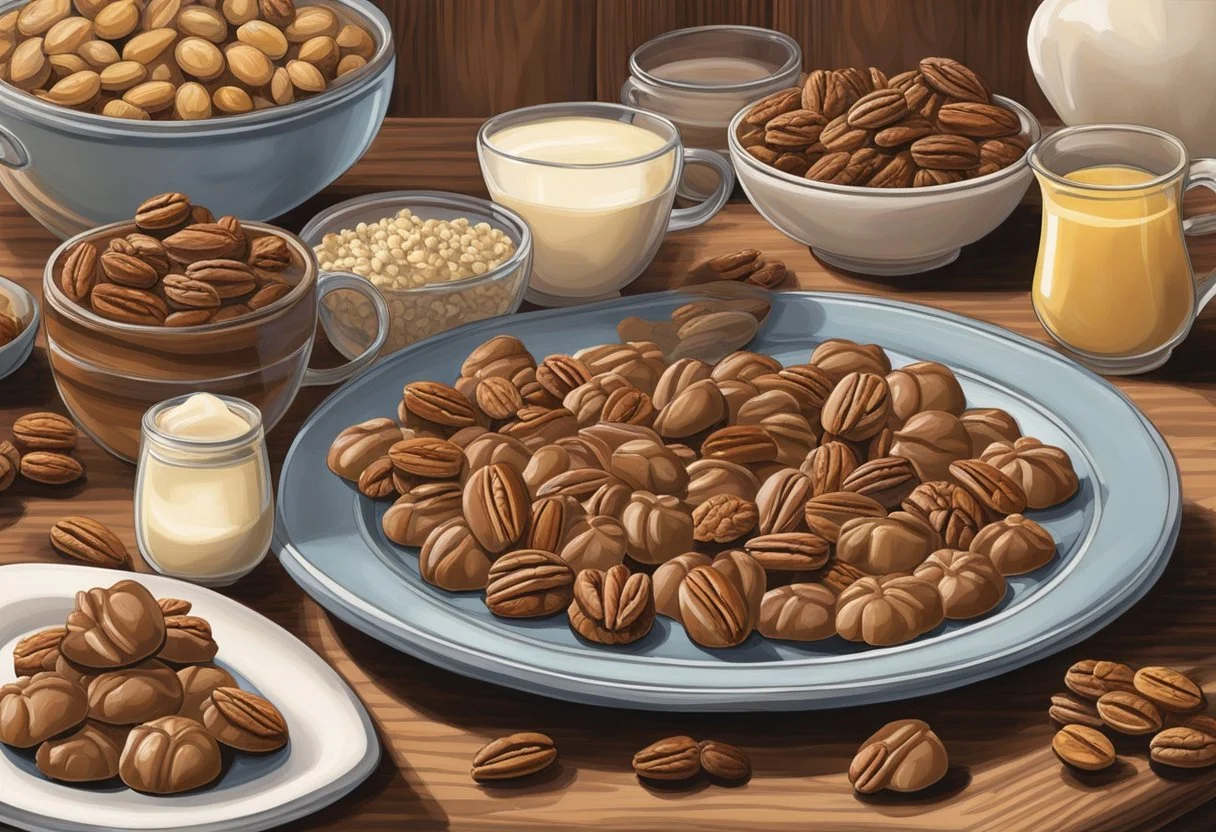Texas Pralines
Decadent History and Authentic Recipes
Discover > Truly Texan > Texas Pralines
The sweet, caramelized flavor of Texas pralines has long been captivating taste buds across the Lone Star State and beyond. These southern treats, which originated in Europe and were adapted upon their arrival in America, have become synonymous with Texan hospitality and confectionery tradition. Notably, Texas pralines distinguish themselves from their European counterparts with the use of local ingredients and a unique preparation method that results in a rich, creamy indulgence.
In the heart of Texas, pecans are a staple ingredient that can be found in many local dishes, and pralines exemplify this tradition. Pecans (how long do pecans last?) form the foundation of these delicious treats, which consist of sugar (how long does sugar last?), cream (how long does cream last?), and butter (how long does butter last?) merged into a delightful cluster. The process of making pralines requires attention to detail, ensuring that the delicious candy possesses the perfect texture and flavor.
Besides their delectable taste, pralines have an intriguing history that adds to their appeal. The recipe was brought to America by French settlers and underwent a Texan transformation with the incorporation of native pecans. Today, these pralines are proudly enjoyed throughout the state and have become emblematic of Texas's culinary culture, representing innovation and preserving a rich historical legacy.
History of Texas Pralines
Origins and Evolution
The history of pralines in Texas begins with its origin in France. Pralines were initially invented in the 17th century by French chef Clément Lassagne, who named the confection after his employer, César, Comte du Plessis-Praslin. These early pralines were made by caramelizing almonds (how long do almonds last?) in sugar, coating them with a hard sugar shell.
In the 18th century, French settlers brought the praline recipe to Louisiana, where they incorporated local ingredients such as pecans, sugar cane, and cream. The result was a soft, creamy, pecan-based confection that became known as the New Orleans praline. This marked a significant step in the evolution of the original French praline into the treat now synonymous with the Southern United States.
Texas Adaptation and Popularity
As the praline recipe made its way into Texas from Louisiana, it further adapted to the local culture and ingredients. The use of native Texas pecans helped shape the distinctive candy, known for its large pecan halves (how long do pecan halves last?) and irresistibly rich taste. The combination of these ingredients with the French heritage and Louisiana traditions created a unique dessert that quickly grew in popularity.
Texas-style pralinces also embraced regional flavors such as:
Vanilla
Bourbon
Cinnamon
These flavors contributed to the appeal of pralines.
Today, pralines have become a beloved confection and cultural symbol statewide. They can be found at local bakeries, candy shops, and even gas stations. The popularity of pralines led to their inclusion in recipes, ranging from pies and ice creams to savory dishes like salads and casseroles. Ultimately, the history of pralines represents a rich fusion of cultures and culinary traditions that reflects the diverse and adaptive spirit of the Lone Star State.
Understanding Pralines
Cultural Significance
With its key ingredients of sugar, butter, and pecans, pralines have evolved into a candy that combines both sweet and savory flavors. Pralines have become an integral part of Southern culture and are often used as gifts for family, enjoyed as an everyday treat, and used as a treat at weddings and parties.
Varieties and Comparisons
There are several types of pralines, each with its unique flavor and texture. These are some popular praline varieties and comparisons between them:
Traditional pralines: A blend of caramelized sugars, butter, and pecan halves. They have a soft, fudgy texture and a slightly grainy texture.
Creamy pralines: Similar to traditional pralines, creamy pralines are made with cream, which gives them a creamier texture and richer flavor.
Chewy pralines: These candies resemble traditional pralines, but they contain corn syrup (how long does corn syrup last?) and more butter, resulting in a chewier, gooey texture. Often considered a cross between a praline and a caramel the corn syrup helps keeps the texture softer.
It is also worth mentioning that despite their similarities, pralines should not be mistaken for brittles or fudge. Brittles are thin, hard, and often made with peanuts, while fudges are a type of confectionery made by heating and cooling sugar, melted butter, and cream. Although pralines share some ingredients with these treats, they are distinct recipes with different preparation and finished result.
Key Ingredients
Pecans: The State Tree Nut
The pecan is the centerpiece of pralines, and their significance goes beyond taste. Found abundantly across the state, the pecan is the official state tree nut of Texas. Their rich, buttery flavor and crunchy texture serve as the perfect foundation for pralines.
To ensure a delicious praline or pray leen, it's essential to use fresh pecan picked at their peak. Choose large, plump, and unblemished nuts (how long do nuts last?) for the best results. Toasting them lightly before adding to the recipe will enhance their natural flavor.
Sugars: Brown vs. White
Sugar is central to any pecan praline recipe, providing sweetness and acting as a binding agent. Most Texas praline recipes call for brown molasses (how long does molasses last?) sugar, white sugar, or a combination of both. Brown sugar lends a warm, caramel-like undertone with its molasses. A balanced blend of brown and white sugars helps to strike the right flavor and texture in the finished praline.
When it comes to brown sugar or white sugar online shopping is the way to go!
Dairy: Butter and Cream
Dairy products, like butter and cream, are integral to the rich, velvety texture of the pecan praline. Butter imparts a smooth mouthfeel and buttery flavor, while cream adds a silky touch.
To control the consistency of the pecan praline and prevent separation, recipe variations may specify heating the butter and cream together before adding to the sugar mixture. Salt is another vital ingredient for enhancing the flavors of the praline.
Lastly, don't forget to add a touch of vanilla. This subtle yet crucial ingredient transforms the flavor, adding depth and harmonizing the flavors, making the Texas praline a timeless classic.
Making a Texas Praline
Step-by-Step Instructions
Begin by gathering the necessary ingredients for the Texas praline recipe:
2 cups pecans
2 cups granulated sugar
1 cup brown sugar
1 cup heavy cream
1/4 cup butter
1 teaspoon vanilla extract
These steps create a delicious batch of pecan pralines:
Prepare the pecan: Line a baking sheet with parchment paper and lightly spray with nonstick cooking spray. Evenly spread the pecan pieces on the paper.
Combine the ingredients: In a heavy-bottomed large saucepan, stir the granulated sugar, brown sugar, heavy cream and milk together and cook.
Cook the sugar mixture: Over medium heat, constantly stir the mixture using a wooden spoon and cook until the sugar has dissolved completely.
Incorporate the butter: Add butter to the pot and continue stirring.
Monitor the temperature: Using a candy thermometer, watch for the mixture to reach between 236°F and 240°F.
Finish the mixture: Remove the pot from the heat and gradually stir in the vanilla extract.
Pour onto each pecan: Once the mixture has cooled slightly, scoop spoonfuls of the syrup onto the prepared pans and each pecan.
Let pralines set: Allow the pralines to cool completely and harden on the baking sheet.
Discover the endless possibilities of buying a baking sheet, parchment paper, saucepan, wooden spoon, and candy thermometer online!
Cooking Techniques
Stirring constantly: To prevent burning and ensure even cooking. Continuously stir the sugar mixture as it cooks.
Heavy-bottomed pot: Using a pot with a thick, heavy bottom helps distribute heat evenly reducing the likelihood of burning.
Pouring the syrup: To create perfectly shaped praline candies, quickly and carefully spoon syrup over each pecan as it can harden quickly.
Using the Candy Thermometer
The thermometer plays a crucial role in making pralines. To achieve the correct texture, the syrup must reach a temperature between 236°F and 240°F.
As the temperature approaches the target range, pay close attention and remove the pot from the heat as soon as the desired temperature is reached.
Flavor and Texture
When it comes to pralines, there are two key elements that define their identity: flavor and texture. Each of these elements is shaped by the ingredients used and the method used during cooking.
Determining Consistency
The consistency of a Texas praline can vary greatly, ranging from chewy to crispy. Some prefer their pecan pralines chewy, buttery and soft, like the Texas chewie pecan, while others enjoy a more crispy, crystallized texture. The difference in texture is determined by the amount of sugar and the cooking temperature.
Chewy pralines: achieved by cooking at a lower temperature - such as the Texas chewie pecan or Lammes pralines
Crispy pralines: achieved by cooking at a higher temperature
Storing and Serving
Shelf Life
To keep your pralines fresh and delicious, store carefully. Keep the pralines in an airtight container to prevent them from drying out, or wrap tightly in aluminum foil. Store at room temperature and keep cool away from direct sunlight and moisture. Pralines can last up to two weeks.
If you need to extend their shelf life, consider placing the plastic box in the refrigerator. This can help the pralines stay fresh for up to a month. However, bring them back to room temperature before serving, as the cold will affect their taste and texture. Keep them wrapped in aluminum foil as they come up to room temperature to stop condensation.
Presentation Tips
When it's time to serve your pralines, presentation is crucial. Here are a few tips for your praline display:
Parchment or Wax Paper: Arrange the pralines on a plate or serving tray lined with parchment or wax paper. They won't stick together and it also adds an elegant touch to the presentation.
Portion Size: To make sure each guest gets to savor the flavors of pralines, prepare and serve them in bite-sized portions. You can either pre-cut them or serve as individually wrapped pieces, depending on the size of the pralines.
Chocolates and Nuts: Complement the pralines by serving them alongside a variety of chocolates and other candy like a Texas chewie pecan. Doing so creates an attractive platter that appeals to friends and relations.
Nutritional Information
Health Considerations
Pralines are a delicious treat not a food, so indulging in them should be done in moderation due to their nutritional content. A typical Texas praline contains a mix of the following nutrients (per piece):
While pralines provide a small amount of protein, calcium, and iron, they are also high in calories, fat (particularly saturated fat), and sugar. Consuming excessive amounts of saturated fat and sugar can lead to various health issues, such as obesity, heart disease, and diabetes.
Serving Size Guidance
To enjoy pralines responsibly, it's important to be mindful of portion sizes. A single praline should be considered a single serving, and it is recommended to limit consumption to one or two pralines as a treat.
Local Impact and Variations
Influence on Local Cuisine
Some popular Tex-Mex innovations include incorporating Texas pecan pralines in salsas, glazes, and toppings. Additionally, these sweet treats are found in traditional desserts such as ice cream, pies, and cookies. The local pecan lend an exceptional flavor and quality to the pecan pralines, unavailable elsewhere.
Celebrations and Occasions
Holiday Traditions
In Texas, pralines are a popular sweet treat for any occasion, but especially during the holiday season. Christmas celebrations often involve sharing these delicious, nutty candies with family and friends. Making pralines at home is a wonderful way to spend quality time with loved ones during the Christmas holidays. The prep time for a batch of pralines is typically around 20 minutes, while cook time takes an additional 10 minutes. This brings the total time to 30 minutes.
Sharing pralines with others is a heartwarming tradition in many Texas homes. They make excellent gifts during the holidays, bringing a taste of Southern hospitality and sweetness to the recipients. One popular way to present pralines as gifts is to arrange them in a beautifully decorated tin or box, with a touch of rose or foil accents for added charm.
When gifting pralines in a box, it is important to take note of their shelf life. These sweet treats are best enjoyed within two weeks of making them, so be sure to share them in a timely manner.





